‘Process’. It's enough to make most people who work in a creative agency shiver. It smacks of uniformity, discipline, rigidity. But to me, it smacks of value, safety and that most elusive of things, intellectual property, or ‘IP’ as its best known.
Allow me to expand on these points.
Assets that walk out the door
It’s a cliché but it has a grain of truth in it too. An agency’s most precious assets leave the building every night. Now only in the metaphorical sense as their staff work mainly from home. But those staff take home with them their knowledge - both of how to do the job and of their clients’ businesses - their skills and those relationships they’ve built up (which are of inestimable value to their employers).

No wonder the current jobs merry go round is causing senior managers at agencies, large and small, to have increasingly sleepless nights. Losing staff unsettles clients, especially if they've put great value on the particular skills and insights that the departing staff member has.
But it doesn’t have to be this way. Other professional services firms have equally valuable staff but whose senior management sleep more easily at night if they leave, largely because they have invested in knowledge management systems that capture and store all those ‘smarts’ and then make them available to new joiners.
Historically, these largely IT-based knowledge systems were so expensive they remained available only to high fee earning firms such as lawyers, accountants and management consultants.
However, Software As a Service (SAAS) has changed that and even the most impecunious agency can afford to install a system where they can store and share information cheaply and easily. If the agency has a half decent CRM system in place, for example, it could be used to ease those sleepless nights.
How we do things around here
Ogilvy’s ‘360 Degree Brand Stewardship’ strap-line is so important to them that its usually accompanied by the symbol sm which stands for Service Mark. Similar to a trademark, it makes it unique to Ogilvy and as such, adds value to its IP.
But look more closely and you’ll see that it’s just a process. Sorry David, but it’s true.
Here’s how Ogilvy describes its legally defensible process, which "employs an arsenal of traditional and proprietary tools to uncover deeper, more actionable insights. We deploy these insights to develop big, differentiating brand positioning, then naming, branding and communicating that positioning in a media-neutral manner”.
Call me an old cynic but I can think of dozens of agencies who would claim to do the same thing. Only they haven’t trademarked their process. Perhaps they should?
Not only would it create a point of differentiation in pitches - incidentally, word has it procurement departments love a good process as they don’t buy the old smoke and mirrors routine from agencies anymore - but it would also make their agencies more valuable should they wish to sell and, most importantly, new staff can be taught how to use the process and so can pick work up work more easily.
Sir Alex Ferguson, former Manager of Manchester United had no qualms in selling David Beckham, one of his most valuable but increasingly antsy players, because any new player was expected to slot into and play his system. Agencies with robust processes in place can adopt a similar approach.
Finally, that process, if branded, invested in and universally adopted, can become the agency’s most valuable asset and its true secret sauce.
We’re big fans of a tool called Method Grid, which we use to capture all the smarts around our agency acquisition and integration processes. Its inventor, Dom Woodhouse, sold his management consultancy to British Telecom for an eye popping £20m primarily because of the value his process gave to BT, who at the time were struggling with large scale project management.
Delivering consistency
Clients, rightly, put a great deal of emphasis on an agency’s creativity. Great creativity translates into great campaigns that helps build brands and sell stuff.
But clients put as much emphasis on agencies delivering consistently great ideas and service. Consistent service can only be achieved if the agency has a robust operating system and process in place.
Few agencies would want to be compared to McDonald’s, but in terms of consistent service delivery, the fast-food Goliath is hard to beat. The reason you’ll never - ever - be served a burnt french fry is because their food cooking system sounds an alarm when the fries are cooked. There’s no ‘I’ll just give it a minute longer then check’ conversations in their kitchen!
Robust agency processes therefore provide a competitive point and if appropriately branded and marketed, can add considerable equity value to the agency.
But most importantly, they provide the basis for a knowledge management system – albeit a rudimentary one – that can capture on a collective basis the agency’s ‘smarts’ and so leave it less exposed.




